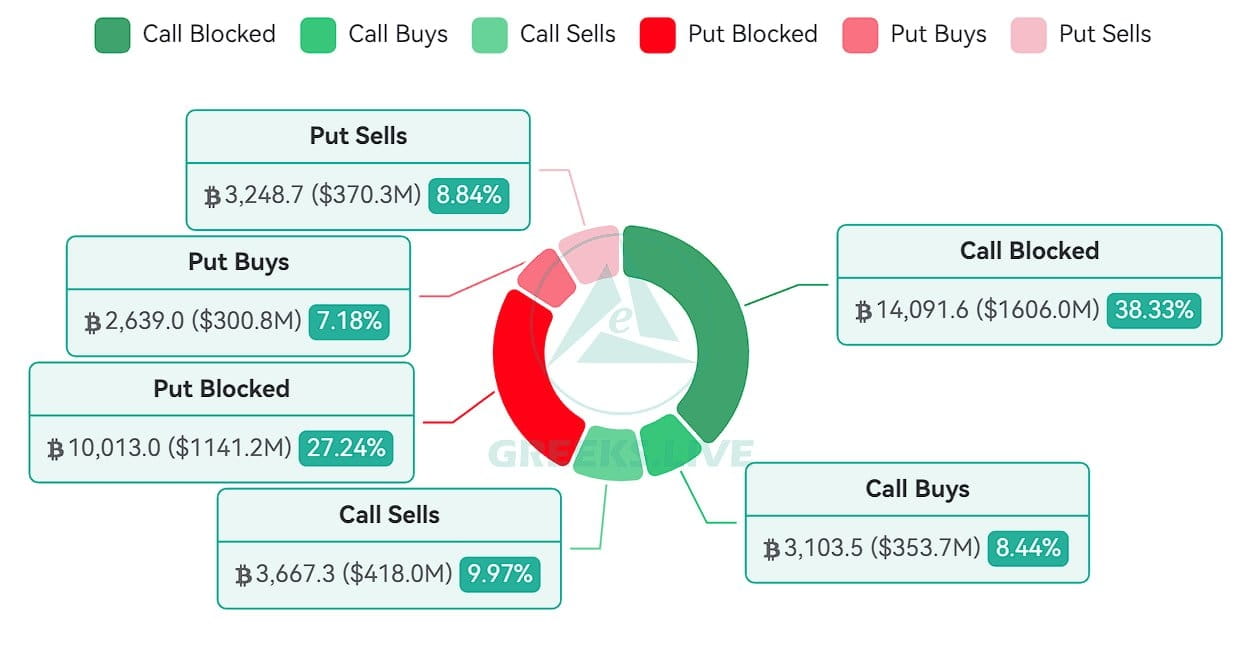As the market prepares for the annual Jackson Hole conference of the U.S. Federal Reserve (Fed), nearly $5 billion in Bitcoin and Ethereum (ETH) options will expire today.
This development could open a period of strong volatility for Bitcoin and ETH, as traders must consider macro signals from the Fed while also facing technical pressure from expiring options contracts.
$4.7 billion in Bitcoin and ETH options are about to expire.
According to data from Deribit, the number of open Bitcoin options contracts currently stands at 33,855, with a total nominal value of $3.82 billion.
The Put-to-Call ratio (PCR) is 1.3, indicating a trend of hedging against downside risk as traders seek protection.
The 'maximum pain' level – meaning the strike price at which most option holders suffer the most losses – is determined at $118,000.

This figure is significantly higher than the spot price of Bitcoin, which is $113,193 at the time of writing.
Meanwhile, analysts at Deribit stated that the expiring Bitcoin options contracts are still heavily leaning towards Puts, reflecting prolonged skepticism in the short term.
On the other hand, the ETH options market presents a different picture, as traders are anticipating a reversal. The open interest (OI) currently stands at 220,630 contracts, equivalent to $943 million in nominal value.
The Put-to-Call ratio stands at 0.83, indicating relatively stronger demand for Call options. The maximum pain point for ETH is identified at $4,250, slightly lower than the current price of $4,284, signaling that the market is approaching a state of equilibrium.

The open interest (OI) indicates a large betting level for both Bitcoin and Ethereum, as the market considers whether prices can maintain upward momentum amidst macroeconomic pressures, or will stall under the effects of hedging flows.
The market is divided ahead of the Fed's Jackson Hole conference.
Analysts at Greeks.live noted that ETH trader sentiment is in a cautiously optimistic state, with many believing that this asset has hit its bottom.
"The main focus is that ETH is outperforming BTC, as traders manage risk by taking profits from Call orders while still maintaining market exposure through short-term Put orders," the report stated.
One strategy attracting interest is to wait for a pullback to the $4,100 level before reopening short-term Call positions. This reflects optimism combined with tactical patience, as the $4,100 level is only about 5% lower than the current ETH price.
These expiring options coincide with the Fed's Jackson Hole Economic Conference, a significant economic event in the U.S. this week.
Traders expect policymakers to signal direction on interest rates and liquidity conditions for the remainder of 2025 during the Conference. Based on this, Fed Chair Jerome Powell's speech at the end of today will be the focal point.
"There is a lot of attention on any signals from the Fed, especially the speech this Friday at the Jackson Hole conference in Wyoming... The market will be watching for direction on future monetary policy," said Nic Puckrin, founder of Coin Bureau.
According to data from Greeks.live, block trades increased and decreased to $1.61 billion and $1.14 billion, respectively, accounting for up to two-thirds of the daily options trading volume.

Short-term implied volatility (IV) has decreased, despite the very large scale of options positions. This suggests that institutional investors do not expect the market to react dramatically to this week's policy event.
Meanwhile, nearly $5 billion in options expiring coincides with the Fed's most important policy conference, creating a high-risk backdrop for both Bitcoin and ETH.
For Bitcoin, traders will face a tough road to reach the maximum pain point of $118,000, about 4.4% higher than the current level. For ETH, the belief that prices have bottomed may help this asset maintain its momentum, although strategies remain cautious.
Whether Jackson Hole creates a shock of volatility or merely reinforces the current calm state, the options market still shows that traders are actively hedging and waiting, with derivative positions reflecting a combination of caution and selective optimism.
